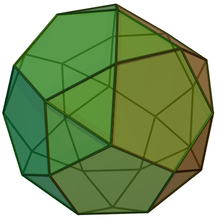In geometry, a birotunda is any member of a family of dihedral-symmetric polyhedra, formed from two rotunda adjoined through the largest face. They are similar to a bicupola but instead of alternating squares and triangles, it alternates pentagons and triangles around an axis. There are two forms, ortho- and gyro-: an orthobirotunda has one of the two rotundas is placed as the mirror reflection of the other, while in a gyrobirotunda one rotunda is twisted relative to the other.
| Set of cupolae | |
|---|---|
 Example: pentagonal orthobirotunda | |
| Faces | 2 n-gons 2n pentagons 4n triangles |
| Edges | 12n |
| Vertices | 6n |
| Symmetry group | Ortho: Dnh, [n,2], (*n22), order 4n Gyro: Dnd, [2n,2+ ], (2*n), order 4n |
| Rotation group | Dn, [n,2]+, (n22), order 2n |
| Properties | convex |
The pentagonal birotundas can be formed with regular faces, one a Johnson solid, the other a semiregular polyhedron:
- pentagonal orthobirotunda,
- pentagonal gyrobirotunda, which is also called an icosidodecahedron.
Other forms can be generated with dihedral symmetry and distorted equilateral pentagons.
Examples
edit| 4 | 5 | 6 | 7 | 8 |
|---|---|---|---|---|
| square orthobirotunda |
pentagonal orthobirotunda |
hexagonal orthobirotunda |
heptagonal orthobirotunda |
octagonal orthobirotunda |
| square gyrobirotunda |
pentagonal gyrobirotunda (icosidodecahedron) |
hexagonal gyrobirotunda |
heptagonal gyrobirotunda |
octagonal gyrobirotunda |
See also
editReferences
edit- Norman W. Johnson, "Convex Solids with Regular Faces", Canadian Journal of Mathematics, 18, 1966, pages 169–200. Contains the original enumeration of the 92 solids and the conjecture that there are no others.
- Victor A. Zalgaller (1969). Convex Polyhedra with Regular Faces. Consultants Bureau. No ISBN. The first proof that there are only 92 Johnson solids.